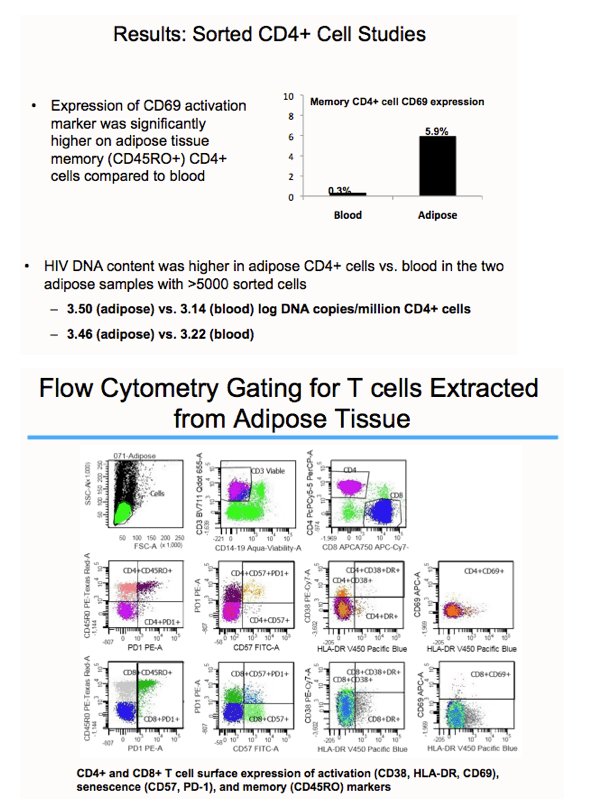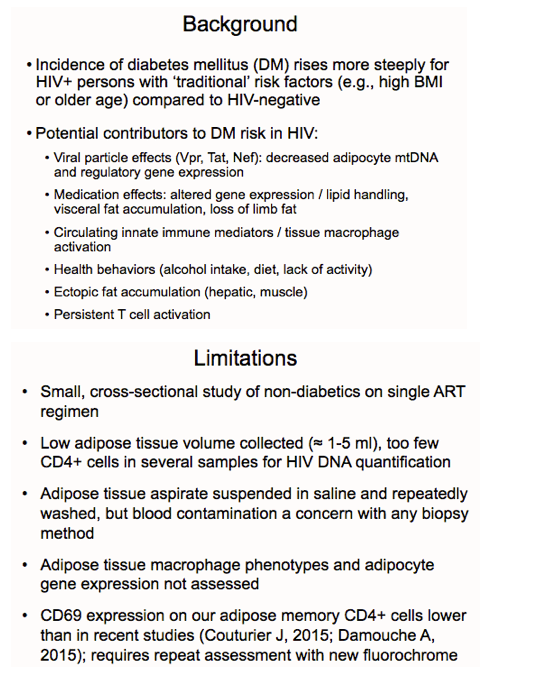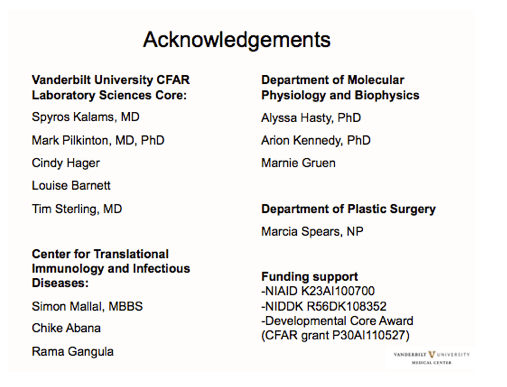 |
 |
 |
| |
Comparison of CD4+ and CD8+ T Cell Subsets in Blood and Adipose Tissue from HIV-infected Persons on Long-term ART..... "Compared with blood, adipose tissue from HIV+ adults is enriched for activated CD4+ & CD8+ T-cells"
|
| |
| |
Reported by Jules Levin
18th International Workshop on Comorbidities and Adverse Drug Reactions in HIV, September 12-13, 2016, New York
JR Koethe1, A Kennedy2, CO Abana1, M Pilkinton1, C Hager1, L Barnett1,
R Smith1, SA Kalams1,3, A Hasty2, S Mallal1,3
Departments of 1Medicine (Division of Infectious Diseases), 2Molecular Physiology and Biophysics, and 3Pathology, Microbiology and Immunology, Vanderbilt University, Nashville, TN, USA
......Compared to blood, adipose tissue from HIV+ persons is enriched for:
-Activated HLA-DR+ CD4+ cells (2.5-fold difference)
-Activated CD8+ cells expressing CD38 (1.8-fold) and HLA-DR (5.8-fold)
AND
.....HIV DNA content was higher in adipose CD4+ cells vs. blood in the two adipose samples with >5000 sorted cells
-3.50 (adipose) vs. 3.14 (blood) log DNA copies/million CD4+ cells
-3.46 (adipose) vs. 3.22 (blood)
Program abstract: In adipose tissue (AT) T-cells modulate local inflammation & adipocyte insulin sensitivity; therefore, we hypothesized the distribution of T-cell subsets in peripheral blood from HIV+ persons may reflect the distribution in adipocyte tissue. We recruited 10 non-diabetic HIV+ adults on ling-term ART to undergo fasting blood collection & subcutaneous abdominal AT biopsy via liposuction. We measured the percentage of CD4+ & CD8+ T-cells in AT and blood expressing activation (CD38 & HLA-DR), senescence (CD57, PD-1), and memory (CD45RO) surface markers by flow cyromemtry. We used doplet digital PCR to quantify the latent reservoir in sorted CD4+ T-cells. We compared the percentage of each T-cell in paired blood & AT using Wilcoxon signed rank tests, and the correlation using Spearman's tests.
Median CD4 was 819, median age was 46 & median duration of ART was 9.6 years. The percentage of CD4+ & CD8+ T-cells expressing activation and senescence markers were generally higher in AT compared with blood (see tables below). The percentages of memory CD4+ T-cells and activated HLA-DR+ CD8+ T-cells were correlated between AT & blood. HIV DNA was only detected in the 2 AT samples with >5000 sorted CD4 T-cells; in both subjects the copy was higher in AT compared with blood (3.50 vs 3.14, and 3.46 vs 3.22 log DNA copies/million CD4+ cells).
CONCLUSIONS: Compared with blood, AT from HIV+ adults is enriched for activated CD4+ & CD8+ T-cells; 2 cell types which promote adipocyte insulin resistance. The correlation between blood & AT percentages of memory CD4+ and activated CD8+ T-cells may reflect a mechanism underlying the epidemiological association between peripheral T-cell activation & the risk for diabetes.


IL-6 and TNF-α decrease expression of peroxisome proliferator-activated receptor-γ2 (PPARγ2) and CCAAT enhancer binding protein. Inhibits development of preadipocytes to fully differentiated adipose cells. IL-6 and TNF-α upregulate hormone-sensitive lipase (HSL) and fatty triglyceride lipase (ATGL), which regulate lipolysis, resulting in decreased lipid storage capacity of adipose tissue and higher circulating free fatty acids







|
| |
|
 |
 |
|
|